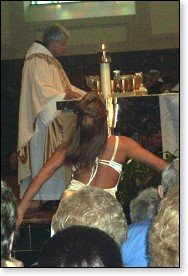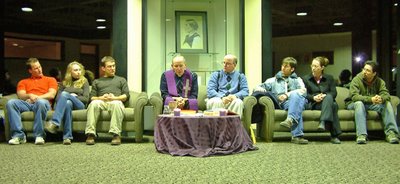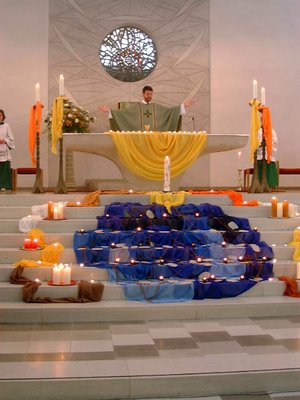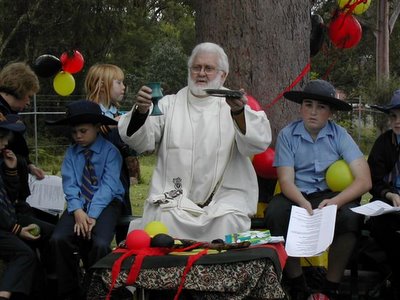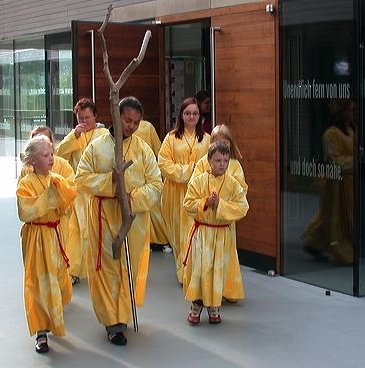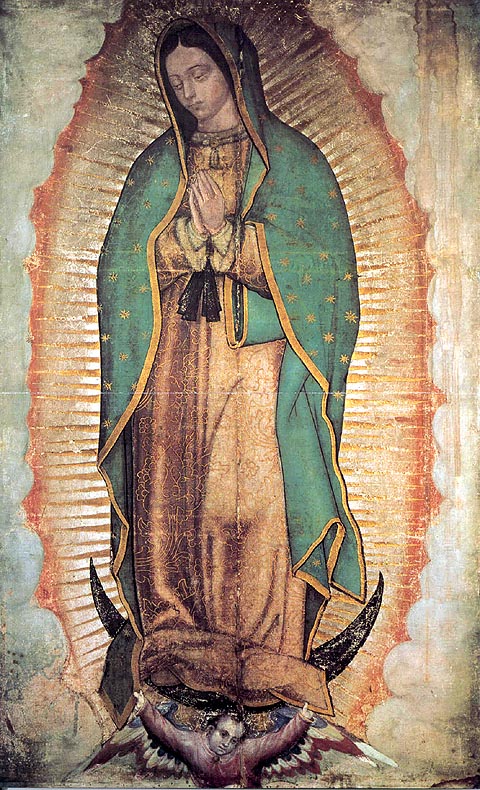
“A time is coming when men will go mad, and when they see someone who is not mad, they will attack him, saying, 'You are mad; you are not like us.” ― St. Antony the Great
Tuesday 12 December 2006
Who crushes the serpent.

Thursday 7 December 2006
Barney loves youuuuu...stand for your "Barney Blessing"
 Perhaps some of you have heard about the goings on in Orange County California. This is the diocese of the infamous Bishop Todd Brown. Bishop Brown is the Bishop banned kneeling at one church and refused to give the Eucharist to a woman who kneet at another. Yet, he tolerates or even appreciates the antics of Father Fred Bailey which took place on Saturday, October 28, 2006. Yes, this is the good father dressed up like Barney!
Perhaps some of you have heard about the goings on in Orange County California. This is the diocese of the infamous Bishop Todd Brown. Bishop Brown is the Bishop banned kneeling at one church and refused to give the Eucharist to a woman who kneet at another. Yet, he tolerates or even appreciates the antics of Father Fred Bailey which took place on Saturday, October 28, 2006. Yes, this is the good father dressed up like Barney!No, not this Barney...
 George W. Bush's dog
George W. Bush's dogNope, not this one...

not quite, but getting closer...

 Well, at least he's dressed for Advent!
Well, at least he's dressed for Advent!
How fantastic is technology that finally these disgusting abuses can be seen by all the world. No longer do we need to just "hear" them and wonder if they are "true" or just come from some "right-wing traddist nutbar." You see the nutbars have been right all along...only now they can prove it and you can see it too with a click of the mouse.
And even better...
Cardinal Arinze has a computer!
Monday 27 November 2006
Oremus, pro Pontifice

Oremus pro Pontifice nostro Benedicte.
Dominus conservet eum, et vivificet eum, et beatum faciat eum in terra, et non tradat eum in animam inimicorum eius. [Ps 40:3]
Pater Noster, Ave Maria, Gloria.
Deus, omnium fidelium pastor et rector, famulum tuum Benedicte, quem pastorem Ecclesiae tuae prae esse voluisti, propitius respice: da ei, quaesumus, verbo et exemplo, quibus praeest, proficere: ut ad vitam, una cum grege sibi credito, perveniat sempiternam.
Per Christum, Dominum nostrum.
Amen.
+ + +
Let us pray for Benedict our Pope.
May the Lord preserve him, and give him life, and make him blessed upon the earth, and deliver him not up to the will of his enemies. [Ps 40:3]
Our Father, Hail Mary, Glory be.
O God, Shepherd and Ruler of all Thy faithful people, look mercifully upon Benedict, Thy servant, whom Thou hast chosen as shepherd to preside over Thy Church. Grant him, we beseech Thee, that by his word and example, he may edify those over whom he hath charge, so that together with the flock committed to him, may he attain everlasting life.
Through Christ our Lord.
Amen
Saturday 18 November 2006
PRO MULTIS! FOR MANY! DEO GRATIAS!
Vatican, Nov. 18 (CWNews.com) - The Vatican has ruled that the phrase pro multis should be rendered as "for many" in all new English-language translations of the Eucharistic Prayer, CWN has learned.
Although "for many" is the literal translation of the Latin phrase, the translations currently in use render the phrase as "for all." All new English-language translations will use "for many" when they appear.

Cardinal Francis Arinze (bio - news), the prefect of the Congregation for Divine Worship, has written to the heads of episcopal conferences of the English-speaking world, informing them of the Vatican decision.
The translation of pro multis has been the subject of considerable debate because of the serious theological issues involved. The phrase occurs when the priest consecrates the wine, saying (in the current translation):
...It will be shed for you and for all so that sins may be forgiven.
The Latin version of the Missal, which sets the norm for the Roman liturgy, says:
...qui pro vobis et pro multis effundetur in remissionem peccatorum.
Critics of the current translation have argued, since it first appeared, that rendering pro multis as "for all" not only distorts the meaning of the Latin original, but also conveys the impression that all men are saved, regardless of their relationship with Christ and his Church. The more natural translation, "for many," more accurately suggests that while Christ's redemptive suffering makes salvation available to all, it does not follow that all men are saved.
Saturday 4 November 2006
The Tridentine Mass: Organic Development and what, if anything, can be gained from the Missa Normative
Soon, perhaps, His Holiness Benedict XVI will release the long-expected news. In a comment on The New Liturgical Movement, Tim states: "not to be maudlin, but do you think Benedict understands that to delay this Moto Proprio until after his dangerous and ill-advised trip to Constantinople is asking for trouble? Tim 11.03.06 " I also think that Benedict should not go to Turkey. I fear for his life. But, go he must and put his faith in Divine Providence. However, this is all the more reason that he must act on these measures before he travels.
I know that Trads everywhere will want to lynch me for this; but, let’s consider for a moment two things; Organic development in the liturgy of the Traditional Latin Mass; and, is if there is anything in the Missa Normative or Novus Ordo rite could be incorporated into the Traditional Latin Mass as “organic” development?
The TLM or Tridentine Rite was codified at the Council of Trent. That is to say, it became the norm for the western church. It was not composed at Trent but it was the way that Mass was said in Rome since the 6th century. Any liturgy at the time that had existed for at least 200 years in the west was maintained—thus we have the Ambrosian, Mozarabic and Sarum Rites. Any changes in the Tridentine Rite since Trent have been slow, moderate and were accepted as genuine development. For example the last was the introduction of Saint Joseph in the Canon after the Blessed Virgin.
Consider what the Council Fathers intended in Sacrosanctum Concilium by way of reform to the TLM liturgy and the Missa Normative which, in my opinion, was not organic growth but a wholesale change and therefore, not what was intended by the Fathers. Many also share this view hence, the “Reform of the Reform.”
Now whilst I am a Choir Director and involved in the Liturgy, I do not consider myself a “liturgist.” I find those post-Vatican II pretenders who use such a term to describe themselves anathema. There are no liturgists; there is only the “Liturgy.” The Liturgy is approved by the Church and is to be carried out with no additions or deletions, simple as that.
Again, the following is only my opinion and is simply put forward as an idea to enhance or grow the TLM with some of what we may have learned to be positive from the Novus Ordo.
Silence is an important part of the TLM. Contemplation, prayer, mystery is found in abundance compared to the noisy and distracting NO. But it seems to me that one good thing from the NO is greater dialogue between the people and priest.
Consider the Confiteor. The priest’s private Confiteor is a must. Traditionally, the “Servers” have responded with the Confiteor on their and our behalf. Would not a public expression of our confession be appropriate? Again, this is not a “change” but, growth.
No doubt the Fathers seemed to have in mind the use of the vernacular languages for the readings. Rather than the readings read by the Priest/Celebrant at the Altar, let them be proclaimed from the pulpit in the vernacular.
The next question is whether or not the Gradual chanted in Latin was to be modified to a response between Priest/Schola and the people. There are advantaged to both. However, if the Gradual is adapted to a response style, it could be in the vernacular, but must follow the Gregorian tones. To introduce the NO style of music to the TLM for this purpose would seem to me a vulgar intrusion.
The Fathers indicated some type of “bidding prayer” what we know as the Prayers of the Faithful. Unfortunately, these follow no pattern and are an opportunity to introduce suspicious intentions. I think perhaps these are unnecessary in the TLM unless they follow a specific pattern that is unalterable. For example: The Pope and Bishops; Unity of the Christian Church; Conversion of fallen-away Catholics; Conversion of non-believers in Christ; the Sick of the Parish; the Deceased of the Parish and the Holy Souls in Purgatory. The final prayer could be a silent one for “our own intentions.” These would be in the vernacular followed by Christ, hear our prayer—Christe, exaudi nos.
Beyond these changes which are to the Liturgy of the Word portion of the mass or what was known as the “Mass of the Catechumens” modifications to the “Mass of the Faithful” or “Liturgy of the Eucharist” must be minimal. There may be some benefit to the Canon being said or even sung in an audible (not loud) voice. Certainly, one advantage of the aloud NO is that abuses become self-evident.
However, there are two practices in the NO that I think would enhance the Canon. The first is the said or particularly sung “Minor Elevation”—“per ipsum, et cum ipso, et in ipso.” It simply seems that this proclamation prayer by the priest is more fittingly proclaimed aloud and in joy for the Sacrifice which has just taken place at the Altar. The second is the dialogue or “Peace” following the Pater Noster. And there is no place for the handshake!
I recall that the Final Gospel was originally said by the priest on his return to the sacristy. But it is a theologically powerful point to maintain. But again, proclaim it aloud and from the Pulpit for all to hear and understand the wonderful theology of John’s dissertation on the Word.
Next: the “Reform of the Reform” to the Missa Normative or Novus Ordo.ive er both what the Council Fathers intended in Sacrosanctum Concilium by way of reform to the liturgy and the Missa NO.
Friday 27 October 2006
Getting back to blogging and a funeral as it should be!
 At the wonderful old age of 91, my mother passed away on October 16, 2006. Obviously, there have been other things to do than blog, but time waits for no one and life continues.
At the wonderful old age of 91, my mother passed away on October 16, 2006. Obviously, there have been other things to do than blog, but time waits for no one and life continues. My mother was a wonderful woman. Of course I would say that. But she really was! Sadly many do not have the mother that I was fortunate enough to have. An old musical colleague prima donna type whose mother passed away a few months ago chanted the song from The Wizard of Oz, in celebration "ding dong the witch is dead."
How sad...how terribly sad.
My mother, Martha, suffered much in her old age the maladies of a life long lived and in service to others. A broken leg, hip and collarbone were all due to falls because no doctor could figure out she needed something as simple as a pacemaker.
But at 82, she underwent emergency surgery for a thoracic aneurysm of the aorta and lived to become famous for it in Toronto emergency rooms. "She had a what?" the nurses would ask, incredulously. So, maybe the system wasn't so bad after all...at least not then!
A few years ago, on New Years Eve, she lost her first son, Raymond; he lost his son, Christopher, her eldest grandson to cancer a few years before--not something a great-grandmother should have to go through; but inevitably, some of the things that happen when you live into your tenth decade.
She always maintained that one of the reasons that she was living so long was that she had something to live for. She wasn't hidden away in a nursing home. She had support from her family and she lived with me. My 18 year-old son whom she helped me care for since he was 3 kept her young. She looked at the ear-ring, nose-ring, lip-ring, blue hair, green hair, purple hair, spiked hair, leopard-skin hair and tatoo with humour and reminded me that he was a "teenager" and that these things too would pass.
Ten years ago, a neurologist diagnosed her as having Alzheimer's. Even her personal physician agreed last year that it was a mis-diagnosis; either that or Aricept is a wonder drug for the treatment of Alzheimer's Disease.
She lived with me, and other than needing help to walk due to a most crippled body from osteo-arthritis, she was functioning fully with all her senses and faculties. Sight, hearing, speech and an appetite as if she was 20. She still charmed everyone she met. She was as sharp on the day she died as she was twenty years ago.
Four days before she died, I turned fifty. A week earlier she wished me a Happy Birthday. I said "Mum, it's next week." "Well" she replied in her ever happy way, with a wink in her eye, "that's just in case I'm not here on your birthday." No doubt, she was tired...she wanted to go, and she was ready.
We had a talk that Friday night two weeks ago as I write this and three days before she died. I acknowledged to her that I understood how hard it was for her. She replied that, "I'm ready to go whenever the good LORD takes me." Well, I told her that when she got to heaven (that I thought God would consider her purgatory was her suffering here on earth) that she needed to remember to pray for me so I would get there too. I said I would miss her when she was gone and she replied, "I'll miss you too!" "Nah," I replied, "You won't miss me, you'll be too busy with St. Charbel and St. Rafqa (a reportedly distant cousin) and making grape-leaves with Aunt Rose for Jesus!" Later in the night she called from her room for me. I asked what she needed, thinking perhaps she needed to use the washroom and she replied, "nothing, I just wanted to know where you were." It was as if she knew it would not be long.
But that's the way we were. And, that's the way she was. She did not fear death. First, she had faith and second, she saw lot's of death in her life and she knew, as best as anyone could know, what to expect. We joked and she understood when I lost my cool at someone or something stupid...a not uncommon trait for me; but she was always there with the sage advice: "Save the trouble, David," she would say. "Save it, save it for what?" I would reply. But she was right. Don't sweat the small stuff. Let it roll of your back. You have thick skin. Be the bigger man. All of these old sayings and cliches that are around because they're true! But more than that, in her own way, she was still teaching the Gospel of Christ. "Turn the other cheek." "Forgive those who persecute you." "Know that they have persecuted me and that they will persecute you." "Love your enemies." She lived it, she taught it and in her old age she prayed for all her family that they would either come back to it, or never lose it.
She left Fredericton at 21 and came to the big city of Toronto where she studied for that nursing career at St. Michael's Hospital in Toronto in the days when the big hospitals all had nursing schools. She loved the old Silver Rail at Shuter and Yonge, Massey Hall, St. Michael's Cathedral, the Sisters of St. Joseph and her nursing vocation. She loved chocolate, kibeh, Lebanese Arak, Captain Morgan Rum and Crown Royal Canadian Whiskey. She smoked menthol cigarettes until she was 88!
Being a nurse in the old days, comfortable running shoes in hospitals were verboten! Nurses wore a white uniform and the starched hat, white stockings and hard leather-soled shoes. Not terribly comfortable on the hard terrazzo floors of St. Mike's. But they looked great in that white uniform under a black wool cope!
They also did more hands on work back then. Fortunately, they could. There were no computers and not anywhere near as much paperwork. They were expected to, well,--nurse. And nurse they did! They lifted patients twice as heavy or more as themselves, cleaned the bedpans, closed the eyes of the dead and said a little prayer. All in time to take the verbal abuse from the holier-than-thou Doctors who thought they were gods unto themselves. But they loved the nuns at St. Mike's and St. Joe's and the hospitals were caring, cost-efficient centres of love and healing. Now there are no nuns the hospitals are not as caring and not as cost-efficient and certainly not as clean.
Before she was a nurse, she was a teacher in Fredericton, New Brunswick. Figuring she'd probably swat some kid for saucing her; she thought she should give up teaching before getting in trouble. Later in life, when I was a young lad, she did return to supply teach in Toronto because of the convenience. That and the ever-present nurses midnight shift so she could be home during the day...when did she sleep?
She met her husband through nursing his mother Farida Doumit. My grandmother ran a boarding house and my grandfather had a grocery store downstairs in a building at 198 and 1/2 Queen Street. Yes there is a "one-half" in the address and the building still stands there today, down the street from St. Patrick's Church and across from the old Rex Hotel. As the story goes my mother heard Farida talking Arabic (Lebanese) and started up a conversation. Well as any good Lebanese mother would do, Farida said to come over for dinner sometime. So after she got out of hospital over my mother went for dinner. The shy guy at the table, Norman, was scolded by his father, Wadea to "get up and walk her home." It was about 6 big city blocks from Queen and St. Patrick to Victoria Street and Shuter. They must have had a good chat on the way, the rest of course, is history.
She did it all.
Two careers, wife, mother of four, neighbourhood nurse, Catholic Women's League President, Moose Lodge Officer and much, much more. She never complained. She just did it! It was done for faith, family and love.
 Martha's funeral took place last Saturday, October 21 at the Toronto Oratory Church of the Holy Family. This was my mother's second parish. She spent the last 15 years of her career as the Director of Nursing in a large nursing home in the same Parkdale neighbourhood. She made it a place of compassion as did the very Catholic owner.
Martha's funeral took place last Saturday, October 21 at the Toronto Oratory Church of the Holy Family. This was my mother's second parish. She spent the last 15 years of her career as the Director of Nursing in a large nursing home in the same Parkdale neighbourhood. She made it a place of compassion as did the very Catholic owner. They were good peopl
 e, he and his wife were nothing like one would read about private nursing homes and, they had a strong, religious, caring, compassionate woman in charge. She even found room at the White Eagle for her old aunt, her mother's sister Eva Deeb who buried husbands and children. Born in Lebanon, old Aunt Eva or "Marcola" died at 97. Of the nine children born to Martha's parents, four made it into their 90's, four died into their 80's and the last one, my godmother Francis, is still going strong at a local nursing home...she will be 99 on January 3, God willing it. (died at 104)
e, he and his wife were nothing like one would read about private nursing homes and, they had a strong, religious, caring, compassionate woman in charge. She even found room at the White Eagle for her old aunt, her mother's sister Eva Deeb who buried husbands and children. Born in Lebanon, old Aunt Eva or "Marcola" died at 97. Of the nine children born to Martha's parents, four made it into their 90's, four died into their 80's and the last one, my godmother Francis, is still going strong at a local nursing home...she will be 99 on January 3, God willing it. (died at 104)I suppose at these ages you pretty well outlive anyone you knew. We joked at the funeral where over 200 attended and 130 sat down after her interment for the "mercy feast" that if she died 10 years earlier, they'd have been overflowing on the street at the church; such was her life; such was the state of her family and friends with so many gone.
My parents did all the things expected of them for a Catholic family in parish life. In fact, it was not out of expectation that they did it and while it was certainly their duty, they always did it with joy. It was just such a natural part of their life. There was no TV and when they bought the first one just after I was born in 1956, there were only two stations; there was no internet, no other worldly diversions. There was home, family and the church. The Catholic Womens' League, Holy Name Society, Altar Guild, Altar Boys, bazaars, fund-raising for the new Catholic school, the new church and so much more.
My family was, and I know my mother would have been, honoured that Father Jonathan Robinson, C.O., the Superior of the Oratory celebrated the Requiem Mass of Christian Burial for her. Father Robinson always says a w
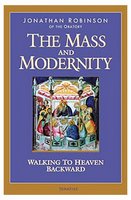 onderful, spiritual Mass. He did nothing different for my mother. I hope the people that came to the funeral not from Holy Family figure this out. He did nothing different than he would on a Sunday. This is not to say that he did not do anything special. He did! He said/sang the Mass as it was meant to be done, thouigh according to the Novus Ordo.
onderful, spiritual Mass. He did nothing different for my mother. I hope the people that came to the funeral not from Holy Family figure this out. He did nothing different than he would on a Sunday. This is not to say that he did not do anything special. He did! He said/sang the Mass as it was meant to be done, thouigh according to the Novus Ordo.He wore a splendid black chasuble with gold trim and design. The sacred vessels were covered in "black." The pall on my mother's coffin was dark purple with a black cross. Not the white that is presumptious that we all go to heaven. There was enough incense to create a run on Salbutimol, the Mass was in Latin, "ad orientem" with four altar servers, seminarians, a young reader with a charming British accent and Father singing the Gospel in English. I know my mother was always fond of Father Robinson from back in the early days of the Oratory. She would recall his blonde hair and smile. She loved the Latin Mass (was displeased with the reforms and preferred the Tridentine); she loved choral music, chant and high liturgy. The highly regarded Toronto Oratory Choir (I am an alumnus) under the direction of Mr. Peter Bishop, M.A., sang. It was a funeral Mass of great solemnity, dignity, prayer and of course, the worship of Almighty God. To me and I think to all of us there, it was also a Mass of Thanksgiving to God for her wonderful life.
The music was the Officium defunctorum a VI by Tomas Luis de Victoria 1548-1611--the stupendously beautiful, moving, overflowing with religiosity-Victoria Requiem.
Even those of none or little faith were moved. That's a good thing--maybe the Holy Spirit will be at work here.
From the opening Requiem aeternam through the Dies Irae to Father's sermon on the inevitability of death, the need to pray for Martha's soul, the need of all of us to proclaim Jesus Christ as LORD, to the "in Paradisum" it was the funeral my mother deserved.
She went by the old Lebanese belief that in everything God comes first followed by your spouse and then your children. She lived the Good News of Jesus Christ every day of her life. She accepted her suffering in the later years with grace and dignity and the will of God. She died the death we can all hope for, quietly, quickly in her own home. No doubt with her beloved St. Anthony of Padua, St. Joseph and of course Her's and Our Blessed Lady Mary at her side to help her.
She loved Jesus more than anyone I know.
She endured in her faith and the Eucharist nourished her in her suffering.
Monday 16 October 2006
Martha Joan Stephen Domet, R.N.
 With sadness at our loss but joy at what was a wonderful life, I wish to announce the sudden passing of my mother, Martha two months past her 91st birthday.
With sadness at our loss but joy at what was a wonderful life, I wish to announce the sudden passing of my mother, Martha two months past her 91st birthday.Martha was a woman of the ages. Teacher, Registered Nurse, Mother, Homemaker, Catholic Women's League President and known as the Mother Teresa of 22nd Street. Mostly, Martha was a woman of faith in her Lord and Saviour Jesus Christ.
To God be the thanks for the Mother who taught me my Catholic faith!

Please visit http://funeralformartha.blogspot.com for funeral information.
Monday 9 October 2006
Fun with pictures...
Saturday 7 October 2006
Feast of the Holy Rosary and a Poem by Chesterton
 Weismiller, T.O.Carm. On his posting for today, October 7, the Feast of Our Lady of the Rosary; Jovan has provided his own erudite comment of the day and has graciously reminded us for our own edification of a wonderful Chesterton poem; White Founts Falling.
Weismiller, T.O.Carm. On his posting for today, October 7, the Feast of Our Lady of the Rosary; Jovan has provided his own erudite comment of the day and has graciously reminded us for our own edification of a wonderful Chesterton poem; White Founts Falling. (click on the Cross)
Monday 18 September 2006
Sister Leonella--the Lioness of Jesus
 Sister Leonella Rosa Sgorbatti, R.I.P.
Sister Leonella Rosa Sgorbatti, R.I.P.This is Sister Leonella who was brutally murdered in the Somali capital of Mogadishu. Shot in the back, four times by brave mohammedan's apparently upset over Pope Benedict's remarks that God and violence for the spread of religion are incompatable, Sister died not long after being taken to hospital. She had worked in Kenya and Somalia for 38 years.
In a memorial Mass today in Nairobi, Kenya; Father Maloba Wesonga says she whispered, "I forgive, I forgive," in her native Italian just before she died. She obviously knew the country well, she used to joke that there was a bullet in Somalia with her name engraved on it. Her funeral will be held on Thursday.
Sister Leonella's name means "Lioness."
She was a Lion for God, she put her love for Jesus into action. She gave her life and in her last breaths took the lesson of Christ to her heart and her lips, "Father, forgive them, for they know not what they do."
Saints are made by God. The Church proclaims them when she is certain of God's actions through them.
Sister Leonella is no doubt already a Saint. Please pray for us St. Leonella and for the Vicar of Christ.
Saturday 16 September 2006
Bishop Fulton Sheen on Islam and Mary
Moslemism is the only great post-Christian religion of the world. Because it had its origin in the seventh century under Mohammed, it was possible to unite, within it, some elements of Christianity and of Judaism, along with particular customs of Arabia. Moslemism takes the doctrine of the unity of God, His Majesty and His creative power, and uses it, in part, as a basis for the repudiation of Christ, the Son of God.
Misunderstanding the notion of the Trinity, Mohammed made Christ a prophet, announcing him just as to Christians Isaiah and John the Baptist are prophets announcing Christ.
The Christian European West barely escaped destruction at the hands of the Moslems. At one point they were stopped near Tours and at another point, later on in time, outside the gates of Vienna. The Church throughout northern Africa ws practically destroyed by Moslem power, and at the present hour, the Moslems are beginning to rise again.
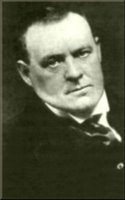 If Moslemism is a heresy, as Hillaire Belloc believes it to be, it is the only heresy that has never declined. Others have had a moment of vigor, then gone into doctrinal decay at the death of the leader, and finally evaporated in a vague social movement. Moslemism, on the contrary, has only had its first phase. There was never a time in which it declined, either in numbers, or in the devotion of its followers.
If Moslemism is a heresy, as Hillaire Belloc believes it to be, it is the only heresy that has never declined. Others have had a moment of vigor, then gone into doctrinal decay at the death of the leader, and finally evaporated in a vague social movement. Moslemism, on the contrary, has only had its first phase. There was never a time in which it declined, either in numbers, or in the devotion of its followers.The missionary effort of the Church toward this group has been at least on the surface, a failure, for the Moslems are so far almost unconvertible. The reason is that for a follower of Mohammed to become a Christian is much like a Christian becoming a Jew. The Moslems believe that they have the final and definitive revelation of God to the world and that Christ was only a prophet announcing Mohammed, the last of Gods real prophets.
At the present time, the hatred of the Moslem countries against the West is becoming a hatred against Christianity itself. Although the statesmen have not yet taken it into account, there is still grave danger that the temporal power of Islam may return and, with it, the menace that it may shake off a West which has ceased to be Christian, and affirm itself a
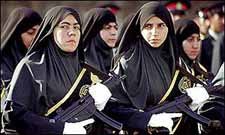 s a great anti-Christian world power. Moslem writers say, When the locust swarms darken countries, they bear on their wings these Arabic words: We are Gods host, each of us has ninety-nine eggs, and if we had a hundred, we should lay waste the world, with all that is in it.
s a great anti-Christian world power. Moslem writers say, When the locust swarms darken countries, they bear on their wings these Arabic words: We are Gods host, each of us has ninety-nine eggs, and if we had a hundred, we should lay waste the world, with all that is in it.The problem is, how shall we prevent the hatching of the hundredth egg? It is our firm belief that the fears some entertain concerning the Moslems are not to be realized, but that Moslemism, instead, will eventually be converted to Christianity - and in a way that even some of our missionaries never suspect. It is our belief that this will happen not through the direct teachings of Christianity, but through a summoning of the Moslems to a veneration of the Mother of God. This is the line of argument:
Mary, Mother of God
The Koran, which is the Bible of the Moslems, has many passages concerning the Blessed Virgin. First of all, the Koran believes in her Immaculate Conception, and also, in her Virgin Birth. The third chapter of the Koran places the history of Mary's family in a genealogy which goes back through Abraham, Noah, and Adam. When one compares the Korans description of the birth of Mary with the aprocryphal Gospel of the birth of Mary, one is tempted to believe that Mohammed very much depended upon the latter. Both books describe the old age and the definite sterility of the mother of Mary. When, however, she conceives, the mother of Mary is made to say in the Koran: O Lord, I vow and I consecrate to you what is already within me.
Accept it from me.
When Mary is born, the mother says: And I consecrate her with all of her posterity under thy protection, O Lord, against Satan! The Koran passes over Joseph in the life of Mary, but the Moslem tradition knows his name and has some familiarity with him. In this tradition, Joseph is made to speak to Mary, who is a virgin. As he inquired how she conceived Jesus without a father, Mary answered: Do you not know that God, when He created the wheat had no need of seed, and that God by His power made the trees grow without the help of rain? All that God had to do was to say, So be it, and it was done. The Koran has also verses on the Annunciation, Visitation, and Nativity. Angels are pictured as accompanying the Blessed Mother and saying:
Oh Mary, God has chosen you and purified you, and elected you above all the women of the earth.
In the nineteenth chapter of the Koran there are 41 verses on Jesus and Mary. There is such a strong defense of the virginity of Mary here that the Koran, in the fourth book, attributed the condemnation of the Jews to their monstrous calumny against the Virgin Mary.
The Significance of Fatima
 Mary, then, is for the Moslems the true Sayyida, or Lady. The only possible serious rival to her in their creed would be Fatima, the daughter of Mohammed himself. But after the death of Fatima, Mohammed wrote: Thou shalt be the most blessed of all the women in Paradise, after Mary. In a variant of the text, Fatima is made to say, I surpass all the women, except Mary.
Mary, then, is for the Moslems the true Sayyida, or Lady. The only possible serious rival to her in their creed would be Fatima, the daughter of Mohammed himself. But after the death of Fatima, Mohammed wrote: Thou shalt be the most blessed of all the women in Paradise, after Mary. In a variant of the text, Fatima is made to say, I surpass all the women, except Mary.This brings us to our second point: namely, why the Blessed Mother, in the 20th century, should have revealed herself in the significant little village of Fatima, so that to all future generations she would be known as Our Lady of Fatima. Since nothing ever happens out of Heaven except with a finesse of all details, I believe that the Blessed Virgin chose to be known as Our Lady of Fatima as a pledge and a sign of hope to the Moslem people, and as an assurance that they, who show her so much respect, will one day accept her divine Son too. Evidence to suport these views is found in the historical fact that the Moslems occupied Portugal for centuries. At the time when they were finally driven out, the last Moslem chief had a beautiful daughter by the name of Fatima. A Catholic boy fell in love with her, and for him she not only stayed behind when the Moslems left, but even embraced the Faith.
The young husband was so much in love with her that he changed the name of the town where he live to Fatima. Thus, the very place where our Lady appeared in 1917 bears a historical connection to Fatima, the daughter of Mohammed.
The final evidence of the relationship of Fatima to the Moslems is the enthusiastic reception which the Moslems in Africa and India and elsewhere gave to the Pilgrim statue of Our Lady of Fatima, as mentioned earlier.
Moslems attended the church services in honor of our Lady and they allowed religious processions and even prayers before their mosques; and in Mozambique the Moslems who were unconverted, began to be Christian as soon as the statue of Our Lady of Fatima was erected.
A Missionary Strategy
Missionaries in the future will, more and more, see that their apostolate among the Moslems will be successful in the measure that they preach Our Lady of Fatima. Mary is the advent of Christ, bringing Christ to the people before Christ Himself is born. In an apologetic endeavor, it is always best to start with that which people already accept. Because the Moslems have a devotion to Mary, our missionaries should be satisfied merely to expand and to develop that devotion, with the full realization that Our Blessed Lady will carry the Moslems the rest of the way to her divine Son. She is forever a traitor, in the sense that she will not accept any devotion for herself, but will always bring anyone who is devoted to her to her divine Son. As those who lose devotion to her lose belief in the divinity of Christ, so those who intensify devotion to her gradually acquire that belief.
Many of our great missionaries in Africa have already broken down the bitter hatred and prejudices of the Moslems against the Christians through their acts of charity, their schools and hospitals. It now remains to use another approach, namely, that of taking the 41st chapter of the Koran and showing them that it was taken out of the Gospel of Luke, that Mary could not be, even in their own eyes, the most blessed of all the women of Heaven if she had not also borne the Savior of the world. If Judith and Esther of the Old Testament were pre-figures of Mary, then it may very well be that Fatima herself was a post-figure of Mary! The Moslems should be prepared to acknowledge that, if Fatima must give way in honor to the Blessed Mother, it is because she is different from all the other mothers of the world and that without Christ she would be nothing.
Wednesday 30 August 2006
Mangled Liturgy older than Vatican II?

Well this is something which I have always believed, not that I have a great recollection of the Tridentine rite from my youth. I was about 8 or so when English was used and I served it as an altar boy a few years later. I conduct a choir now for the splendid Tridentine Mass said with care and dignity. I also love the Novus Ordo when said properly without shortcuts and improvisations. I simply love the mass.
Having conducted a schola and choir for the Tridentine since May, I can see that it too could have been open to abuse.
Just follow my train of thought. I can't remember the saint, somewhere around the 12th century but he had doubts about the Real Presence and there was one person in the church. He thought the man a fool after he said the words of consecration and he was stunned to see actual flesh and blood on the paten. So my point is, with the Canon said in silence and the fact that all men are sinners and heretical or careless priests did not just come along in 1970; it is possible that he could be just saying yada, yada, yada and the faithful would never know. It's one advantage about the Novus Ordo--we can clearly see and hear the abuses!
Which brings me to a most excellent column on the Holy Eucharist by Benedict M. Ashley, O.P. and as Father Richard John Newhaus would say, "you're always considered a convert" as was Father Ashley.

Here is the first paragraph which you can click on to link.
We have all suffered at Mass from the intrusive, even sometimes heretical modifications of the liturgical texts by "creative" priests; from the banal translations of some of these texts; from the inaudible or mangled reading of them by lay readers; from fatuous hymns or badly strummed guitars, etc., etc. Should we blame this on Vatican II and its Novus Ordo and call for a return to the "Tridentine" Mass?
Sunday 27 August 2006
More Discovery of Gregorian Chant and a little something on Donnie and Marie
 In the appropriately named town of Bethlehem in Connecticut the Abbey of Regina Laudis can be found. These are Benedictine Nuns following the Divine Office as prescribed by St. Benedict. The Office begins at about 2:00 A.M. with the nuns rising to sing the Office of Matins.
In the appropriately named town of Bethlehem in Connecticut the Abbey of Regina Laudis can be found. These are Benedictine Nuns following the Divine Office as prescribed by St. Benedict. The Office begins at about 2:00 A.M. with the nuns rising to sing the Office of Matins.  Yes, that is AM! Going back to bed, they rise early to sing Lauds followed between their daily chores by Prime, Terce, Sext and None. At some time in late afternoon before supper there would follow Vespers and then just a few hours later before bed, Compline.
Yes, that is AM! Going back to bed, they rise early to sing Lauds followed between their daily chores by Prime, Terce, Sext and None. At some time in late afternoon before supper there would follow Vespers and then just a few hours later before bed, Compline.In its compromise to the modern world, the Church’s Liturgical “periti” renamed and restructured the Divine Office in the early 1970’s as the “Liturgy of the Hours.” This much reduced form of the Divine Office includes the Morning Prayer (Lauds), Evening Prayer (Vespers) and Night Prayer (Compline).
 In yesterday’s Hartford Courant, writer William Weir discovers the nuns and their office and the Divine sounds of the chant. More and more we can see the secular world taking notice of this beautiful tradition, in no small way due to the election of Benedict XVI. Prior to his election as Pope, Cardinal Ratzinger’s views on liturgy, polyphony and chant were well known. At some point very soon the Pope must respond to last years’ Synod on the Holy Eucharist. The report from the Commission was received by the Holy Father in June. Presumably, he has been using part of his time at Castel Gondalfo to ponder his response.
In yesterday’s Hartford Courant, writer William Weir discovers the nuns and their office and the Divine sounds of the chant. More and more we can see the secular world taking notice of this beautiful tradition, in no small way due to the election of Benedict XVI. Prior to his election as Pope, Cardinal Ratzinger’s views on liturgy, polyphony and chant were well known. At some point very soon the Pope must respond to last years’ Synod on the Holy Eucharist. The report from the Commission was received by the Holy Father in June. Presumably, he has been using part of his time at Castel Gondalfo to ponder his response.Whether by accident or design (and in these matters, there are no coincidences) a convergence of issues all related to the liturgy is near.
The Vox Clara Commission must soon complete its work on the ICEL translation of the Roman Missal for the English speaking world. A translation more literal from the Latin original and poetic will be the result.
While Bishop Fellay of the SSPX has said just recently that there has been no action on the reunification of the Society and that it may take “years,” Benedict has made church unity a major goal of his pontificate. Where else to start than with traditional Catholics?

Can we hope that the “Reform of the Reform” so often talked and written about is not that far away?
The Nuns of Regina Laudis know something about Gregorian Chant and its relationship to prayer, contemplation and worship. Now the readers of the Hartford Courant know, we can only hope (and pray) that soon the Catholic in the pew will find out what these Benedictines never forgot.
Gregorian chant signals return to tradition
By William Weir Hartford Courant
BETHLEHEM, Conn. – On a recent Monday at the Abbey of Regina Laudis in Connecticut, about 35 nuns gather in a dim chapel to chant, as they do every day at noon. Making their way through Psalm 118, the nuns sit or stand; some face different directions, while others bow steeply. Throughout, their voices remain in unison.
Pope Benedict XVI would approve. After a concert of 16th- and 17th-century music recently, the pope said he would prefer to hear Gregorian chant and other traditional types of music play more of a role during Mass. That’s good news for the cloistered nuns at the Bethlehem abbey, which is known around the world for its devotion to Gregorian chant and is one of the few places where it is sung with such frequency and intensity. The nuns sing seven times a day; some interrupt their sleep to chant at 2 in the morning.
But the pope’s comments also raise certain questions: What is sacred music supposed to sound like? And what’s wrong with new music in church?
It’s a debate that has raged since 1963, when Vatican II reforms brought contemporary music to Catholic churches. Just as the Latin Mass almost immediately disappeared amid attempts to modernize, chants gave way to guitars and snappy folk tunes. The new music helped fill pews, but it left church conservatives and formally trained musicians reeling. How could the church that brought about Gregorian chant, polyphony and musical notation – all profound influences on Western music – be the same one leading sing-alongs of “Love Is Colored Like a Rainbow” and songs from hit musicals?
What, bemoaned the purists, had the folkies wrought?
Going to church, critics say, should not sound like shopping at the mall or driving your car. They charge that “liturgical pop” is spiritually bereft and demands nothing from the churchgoer. It’s friendly, pleasant and easy, they say. They mean that in a bad way. Understanding God is hard work, the argument goes, and similarly, music in church should challenge us. A sermon that says only what people want to hear would lack moral authority. The same goes for music.
“There’s a sense of mystery and religious atmosphere that seems to be lost in the new days,” says Scott Turkington, the choirmaster at St. John the Evangelist Roman Catholic Church in Stamford. “The fact is that the older music is better. Ask any serious musician, and he’ll agree with that.”
The chants sung at Regina Laudis are more than 1,000 years old. But Sister Elizabeth Evans says “old” doesn’t mean “irrelevant.”
Sister Elizabeth, 46, was a corporate securities attorney and law professor before she came to the abbey in 1997. Each of the nuns is assigned certain responsibilities; hers are music and dairy. Sitting in a small room behind a wooden screen (which symbolically separates the nun’s world from the visitor’s, although there’s enough space to shake hands), Sister Elizabeth remembers stumbling onto the sound of chant when she was 14. To her, it was anything but off-putting. She played it for her friends, who were equally taken. “And I mean, these were 14-year-old gum-chewing delinquents like myself,” she says.
To the untrained ear, the unaccompanied chant named after Pope Gregory the Great can sound emotionally muted, droning at times and otherworldly. That it’s sung in Latin doesn’t help.
But to Sister Elizabeth, it sounds more recognizably human than any other music, down to earth and in tune to the rhythms of life. It’s based on the Scriptures, after all, which are filled with human foibles.
She says chant is like blues legend Muddy Waters – a comparison that conjures the improbable image of nuns chanting “Baby, Please Don’t Go.” She explains that both have a certain earthiness and deal with the nitty-gritty of life.
What they chant depends on the time of the day (the morning lauds, for instance, often celebrate beginnings and creations; at noon, they chant the sext, which deals a lot with chasing down noonday demons). Subjects also change along with the seasons. Lately, they’ve sung about taking in harvests, filling storage houses and other day-to-day concerns.
So if chant is like Muddy Waters, what’s contemporary Christian music?
“Donny and Marie,” Sister Elizabeth says, laughing.
© 2006 Journal Gazette and wire service sources. All Rights Reserved.http://www.fortwayne.com
Wednesday 23 August 2006
Raymond Stephen Vincent Domet
A few years earlier, Raymond's son, Christopher John Domet living then in Hamilton, Ontario with his wife and two little girls, died of cancer. In 2004, I composed a Christmas Mass titled "Mass of the Father's Love" based on Divinum Mysterium--Of the Father's Love Begotten---so this is not totally diverse from music. It was written for the Novus Ordo Mass and since I am now conducting for the Tridentine, it's not particularly usable. As well, with the changing coming to the texts in the Mass due to the "real" translation from the Latin, much of this composition, the Gloria in particular, is redundant. It will take some work to adapt it--perhaps some day.
The Mass was dedicated to Christopher and given to Ray as a Christmas present. Ray was planning to come to hear it at St. Teresa Catholic Church on New Years morning (where Christopher was baptized and he was married and we all grew up as a family). Raymond did not come to Mass that morning to hear the Mass and the music dedicated to his son, he died the night before. I think the hardest thing I've ever done in my life was telling his mother who was then 89, that her son was dead. I will never forget it.
Raymond's funeral was at St. Francis of Assisi parish in Mississauga. Other than the Gloria (not sung or recited in a Mass of Christian Burial) the Mass of the Father's Love was sung.
I like to think he finally got to hear it.
Raymond had a blog. I can remember asking him so many times, "what' a blog again?" Well, I figured it out. On his blog, he wrote what was then to be his "last post" and I've reprinted it below.
Requiescat in pace, dear brother.
Monday, December 27, 2004
Mass Of The Father's Love
My 12-year younger brother made me cry on Christmas Day. Not an easy task for a person who has no tears. Actually I 'cry' a lot with my situation the last few years. It used to be mostly pity parties, as some have termed the phenomenon, woe is me, why is God doing this to me, I do not deserve this.... I am generally moved beyond that, especially because useless and counter-productive emotion aggravates my breathing almost instantly, and that is not needed at all!
Most of my crying is at a close to the surface emotional engagement and intimate entanglement with event or person or art or entertainment. So it was last week when RadioBoy took CaraMia and I to see the film version of The Phantom Of The Opera. Yes, I commented right away that the Phantom did not have a powerful voice as one would reckon, recalling the two performers I saw at the Toronto stage production, and the original Broadway performer. But there I was shaking and hyperventing in my theatre seat nonetheless, at the majestic and captivating music of the night, and all the other pieces so fondly recalled.
My brother, whose interest in classical and liturgical music is long-standing, and barely short of professional, made all of us cry.
He has written A Mass For Christmas, Mass Of The Father's Love. It is being presented this season, and i will hear it either this New Year's Day, or the following Sunday, at his home Church, Where CaraMia and i grew up, where we exchanged our vows, hey, the basement of which is where the whole Roy Orbison Pretty Woman DJ Ladies' Choice thing began! It is also where our first-born, Christopher, (bearer of Christ) was baptized. And it is to the memory of our gone too soon son that LittleBro has dedicated his opus! There's more. In LittleBro's own words...
The title of this Mass...is a direct reference to the divine love of God, the Father.... Metaphorically it is an earthly reference to the "father's love" given to Christopher by his own father. This Mass composition is therefore dedicated to Christopher John, whom I never heard complain, and who suffered greatly in his sojourn with cancer: and to his father, who loves him.
Wow. Today we gathered at Mom's home, where LittleBro and his son live, with Mom. A fine turkey dinner was provided and a good visit, with the grandbabes seeing their Sitto and Uncles and charming us all again with their beauty and grace and intelligence. Much love to their Mom, M, who has had to raise them without her beloved Christopher at her side.
And a thought to my Dad, who wrote a song for Mom so many years ago. Where Did You Learn To Kiss? He also, after barbering coughed up a bit of money he could spend on himself, purchased an electronic organ, taught himself to play, and enjoyed a bit of his retirement. But consider, in my Family, our musical talent. LittleBro, he writes a Mass. MiddleBro, he like me, may not be able to carry a tune in a bucket, but his son is a professional musician, teacher, director, so talented. MySister's elder daughter has a most accomplished voice, and sends chills upon my spine when I hear her exquisite voice with Wind Beneath My Wings when she was sixteen, to the Ave she sang at her sister's wedding last year.
Thanks LittleBro. Thanks Dad. Thank you Father Almighty.
Posted by: Ray / 9:34 PM (1) comments
Thanks Ray!
Wednesday 9 August 2006
Pray for the Land of the Cedars

While most of my BLOG commentary deals with sacred music and the state of the liturgy, at times like this it seems that even these important matters becomes trivial.
Over 120 years ago in 1886, my maternal grandfather, Domenic Haykel left the beauty of Mount Lebanon for an unknown future in Canada. Leaving Halifax his port of entry, Domenic made it as far as Fredericton, New Brunswick, became a British Subject and a few years later returned to find the love of his life, Naza (Elizabeth Deeb). They had one child in Lebanon and then returned to Canada's Maritimes and had 9 more. They were active at St. Anthony's Church in Fredericton.
In 1910, Wadea Doumit (the family name means "Dominic") and his bride, Farida Francis (a first cousin) came to Toronto and lived in a walk-up tenement building on York Street where the new Toronto Stock Exchange now stands. For a short time they were members of St. Anne's Parish but eventually became part of St. Patrick's.
 Both grandfathers became merchants. Three of Domenic and Elizabeth’s sons became millionaires and their Alma Mater was the school of hard knocks. Wadea and Farida never owned their own house but during the Great Depression Wadea fed the locals from the back door of his store at Queen and St. Patrick Streets and he later bought two houses for his young married sons one of which I now own.
Both grandfathers became merchants. Three of Domenic and Elizabeth’s sons became millionaires and their Alma Mater was the school of hard knocks. Wadea and Farida never owned their own house but during the Great Depression Wadea fed the locals from the back door of his store at Queen and St. Patrick Streets and he later bought two houses for his young married sons one of which I now own.My maternal grandfather must have been one of the first Lebanese to leave that beautiful land to come to Canada. At that time Lebanon was a province within the Ottoman Turkish Empire and not too many from Mount Lebanon were happy about that. The Maronite Catholics on Mount Lebanon were a faithful and brave lot. They kept their faith in Jesus Christ despite the Mohammedans and their ultimate victories against the Crusaders. But then like now their persecution was sometimes too much to bear. For almost 100 years it was the Druze that murdered thousands.
Yet, they prospered and like their Phoenician ancestors they explored the world. Originally they spoke Aramaic, the language of Our Lord, the same Jesus who walked in their cities of Tyre, Sidon and Cana, site of His first miracle. Eventually they became part of the Arab world but never Arab. That is why they are so resented; for keeping a focus outward to Europe and the Americas and Oceana unlike the Bedouin and Mohammedans.
After the Ottoman Turks crumbled came the French who rescued the Christians from the Druze and who helped to prepare the land for its independence in 1946, two years before another new land, the State of Israel.
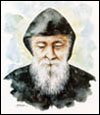
So ironic today that Lebanon which other than participating in the initial 1948 conflict never, ever attacked Israel or joined in any of the middle-east wars since 1948 should be so brutalized.
But is this brutality solely the fault of Israel?
The Palestinian terrorists, even the name Palestinian has become synonymous with the “t” word, who first came on the scene in 1972 in Munich took the name “Black September.” Eleven innocent Israeli Jewish athletes were brutally murdered during the Olympic Games. The next few years would see more hatred and turmoil and loss of innocent life at the hand of Black September, Fattah and the PLO. Allied with other Marxist terrorist groups of the cold war period including the Beider-Meinhoff, IRA, Basque Separatists and the Red Brigade in Italy, terror reigned supreme.
A few years before Munich, Black September took place in Jordan. Trans-Jordan, the nation of the Hashemite Kingdom was under a British Mandate along with Palestine after the Ottoman Turkish Empire collapsed at the end of World War I. The new Kingdom of Jordon became home for thousands of Palestinians, most of whom got on with life and have become part of broader Jordanian society. Yasser Arafat, born in Egypt of Palestinian parents was the leader of the Fattah movement. With his followers they attempted to subvert the government of King Hussein in Jordan until in September 1970 they were attacked and deported for the treason they committed on a welcoming land. A treason that they repeated in Lebanon and Kuwait later.
The goal of the PLO has never changed. Israel must be wiped from the face of the earth. Not necessarily every Jew killed but every Jew killed if necessary.
And then they went to Beirut.
More preoccupied with developing a pluralistic, dynamic, prosperous society, the Lebanese then as today had not much of an army.
With thousands of Palestinian refugees in south Beirut, in Tyre and throughout the south, often in camps, Arafat exploited their poverty and suffering and upset a finely balanced government plunging Lebanon into chaos. He subverted the government, betrayed the Lebanese people and invoked the wrath of Israel and the disdain of the civilised world (well most of it, anyway).
All those years of suffering amongst the Lebanese people has begun again. Why?
Is it as simple as the Palestinians who can’t have their own land right now have to destroy the only pluralistic land in an otherwise intolerant region?
The Palestinians are suffering, no doubt; and tragically they have been deceived by their leadership and the Arab world and from the suckling at their mothers’ breasts have learnt nothing but hate.
They must reject Mohammad, join their few brethren who belong to the Melkite Rite and accept Jesus Christ as their LORD and Saviour. Then, they will have the peace they so long for.
Sunday 25 June 2006
Vatican liturgical official seeks recovery of the sacred
If one takes the time to read Sacrasanctam Concilium there were eleven specific requests of the Council Fathers. Yet, what was thrust upon the spirit and mind of every Catholic was far from what was expected. Many of us can take the position that it was a "conspiracy" on the part of certain Vatican officials but the real crime was the "conspiracy of silence" that existed by almost every bishop alive in 1970 who were at the council and accepted the banal and spiritually weak Mass of Paul Vi. Perhaps Paul was part of this conspiracy, perhaps he was gullible and weak. Regardless, history has shown him to be a weak and ineffectual Pope.
After two months now conducting the choir at a Tridentine Mass it has really come home to me how bad the reform really was. I always knew it; and I had attended Tridentine masses perhaps a half-dozen times since the age of eight, so I was not unfamiliar with it; but I defy anyone with an open mind to look at what we had then and what we have now and not believe that we lost something.
Take one example, clearly an abuse that was never called for in the documents. How many churches still have altar boys/girls holding the paten under the chin to catch the Eucharist or crumbs if it falls? Of course there is no need if it is given in the hand. But I can clearly recall serving in the transitional period and we used the patens. Taking it back to the altar, we used two hands and it was never tipped. We placed it on the altar and I could clearly see little crumbs--like white pepper--on the paten. The priest wiped these particles of the Body of Christ with his finger into the chalice. I would the pour water over the priests fingers to wash the particles into the chalice which he then consumed. So where are these particles now and what does it say about our belief in the Real Presence?
I lost something! So did the generation that grew up with the Novus Ordo. We lost solemnity and a sense of the sacred. We changed the sacrifice of Calvary to a communal supper. Just look at the beginning of the Tridentine Mass and the Prayers at the Foot of the Altar; "I will go in unto the Altar of God, the God who gives joy to my youth." The first words from the priest indicated that he was about to do something holy and worthy. Now we are lucky if the first words even conform to the rite and don't end up as a rehash of last night's hockey or world cup game.
So what will Benedict do? Clearly in the English-speaking world, the least will be the re-translation of the English Novus Ordo. This is an exercise almost complete and hopefully will be implemented soon. As one example, rather than "This is the Lamb of God who takes away the sin of the world, happy are those who are called to his supper" we will hear, "Behold the Lamb of God, behold He, who takes away the sins of the world, blessed are those who are called to the supper of the Lamb." Who said English cannot be poetic and uplifting?
We most certainly should see some broader return of the Tridentine Rite, perhaps with an updated missal with a new saints calendar. If not, then the old rite simply is "old" and not living. Will we have two rites, the Tridentine and a Novus Ordo which takes more from the Tridentine to make it more sacred?
The real mistake was that the changes were not "organic". The new mass was a different rite and inferior at that. A priest could consecrate bread and wine to the body and blood of Christ at a picnic table. Technically you don't need to surround it with the "mass." But that would not make it licit. We are dealing with a liturgy that has caused a falling away from the church and the seminaries and that is the greatest sadness.
The news article below indicates that we are not far from some new order. We can pray for courage for Benedict XVI and Cardinal Arinze who will no doubt have a fight on their hands. The protestant Catholics are not going quietly, but go they must. Christ said that in the last days there would be many who would lead astray even the elect. The time has come for all Catholics to see the last 40 years for what it is--a spiritual desert!

